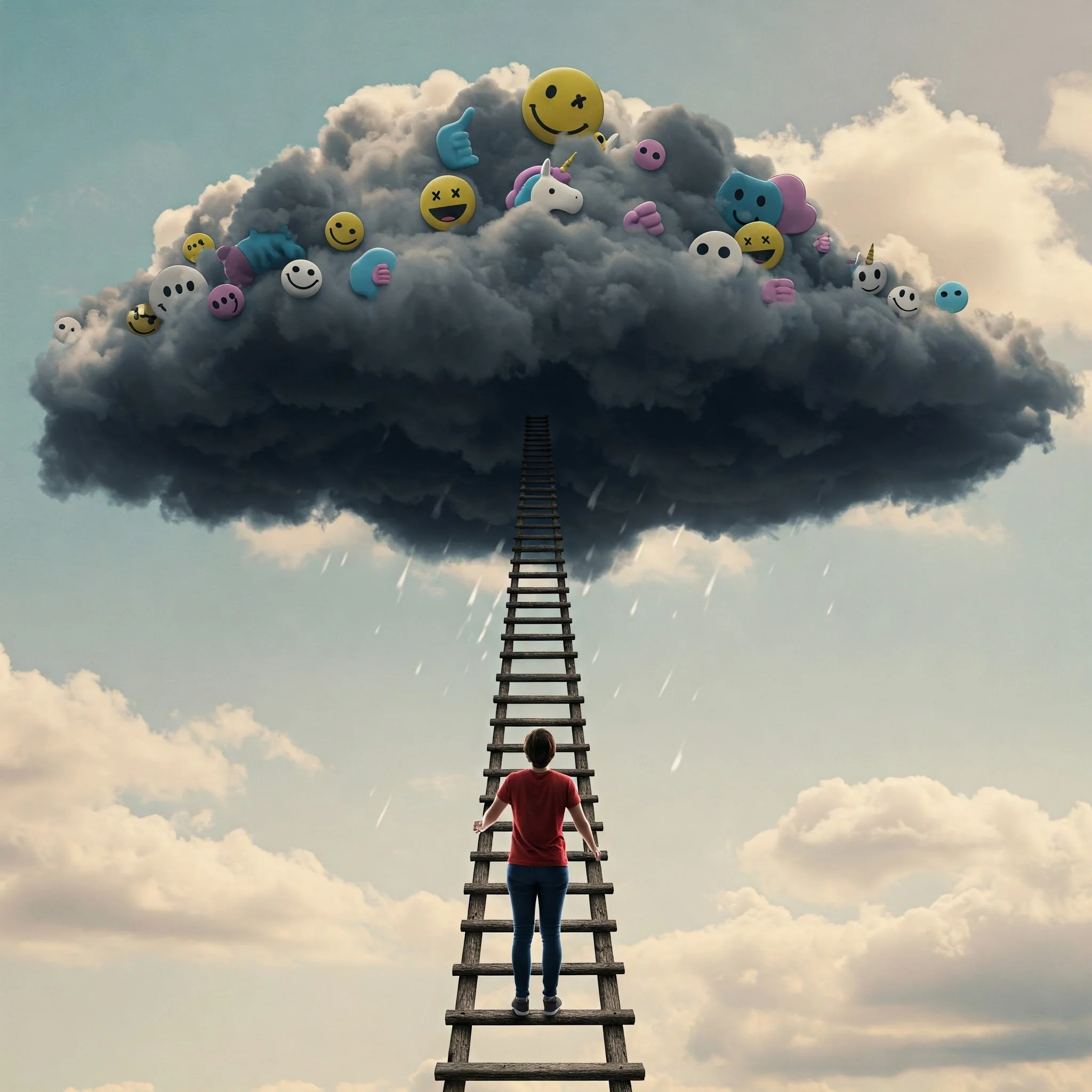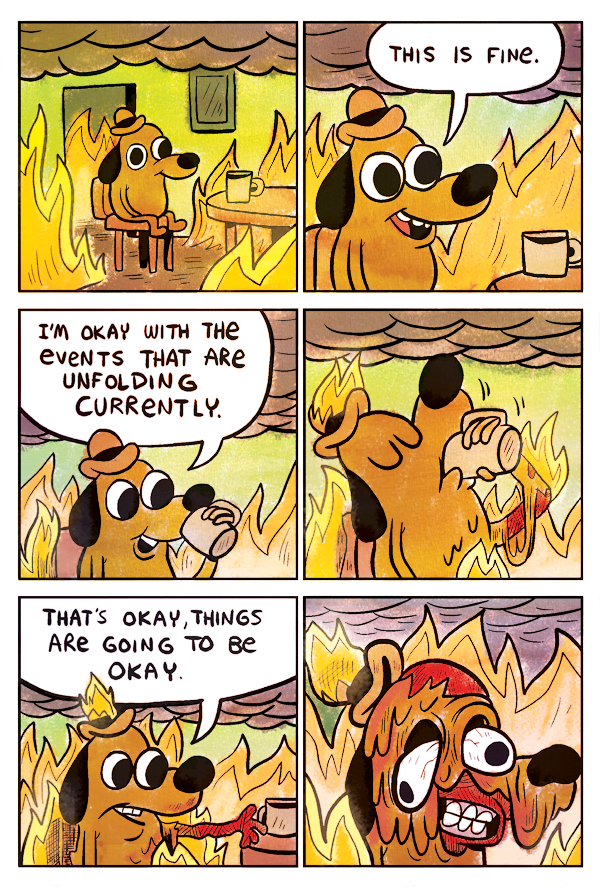Bad vibes only
Holding space for the messy and negative
January 30, 2025Image generated by AI: Imagen 3, with Gemini Advanced 1.5 Pro
It has happened to the best of us. Something bad happens and in sharing it with someone we are met with a “just think on the bright side…”, “everything happens for a reason…”, “count your blessings…”, “at least [insert the one thing we’re supposed to be grateful for even though it does not solve the problem at hand]...”.
Our lives, friendships, workplaces and societies are inundated with the pressure to maintain a positive outlook, feeling less and less like an invitation, but more so an obligation.
It may go as far as being blamed for adversity out of our control because we “manifested it”, “didn’t manifest the good” or “were not grateful enough for what we already had”. It may go as dangerous as being told to “assume good intent” from someone who has caused harm or that “boys will be boys”, or even “I’m sure they didn’t mean it”, in a way that strips us from justice and reparation and them from learning and accountability.
All these are examples of toxic positivity.
And because this will be a recurring theme in our conversations together, today I want to talk about its definition and share some backstory behind the title of this publication.
This term is said to have been first coined by Jack Halberstam in their 2011 book The Queer Art of Failure and offers a reflection on Barbara Ehrenreich’s 2009 book Bright-sided, which argued that positive thinking is a “mass delusion” afflicting the US, and putting successful outcomes entirely in the hands of positivity and being a good person. While the term toxic positivity seems quite recent, the concept and similar ones such as “unrealistic optimism” have been a subject of exploration for decades, with Neil Weinstein writing in 1980 that people believe that “success happens to good people and failure is just a consequence of a bad attitude rather than structural conditions” (1).
We can define toxic positivity as a belief that all negativity should be rejected, and people should maintain a happy, optimistic and positive mindset at all times, no matter the circumstances. It also implies that those who cannot maintain this constant state of bliss are “flawed and in need of transformation” (2).
One of its main consequences is the denial, invalidation or gaslighting (3) of human experiences and emotions, usually those that are considered “negative” and that disrupt the carefully curated illusion of perpetual positivity in which many people and groups like to live. This can be particularly harmful to marginalized communities who already face systemic obstacles.
From “Gunshow”, by KC Green, strip 648 (2013)
Bad vibes, please
As a highly sensitive, restless person with a keen eye for detail (no, really, my mom used to say that “The Princess and the Pea” by Christian Andersen was about me) and a passion for sharing that occasionally outpaced my tact, I have found myself in trouble for speaking up. I asked why, I questioned the way things were done, I spoke up when I saw injustice, I talked back to figures of authority, I called out misbehavior.
This is not to say that I was right or righteous all those times, yet my words were honest in that they revealed how I was truly perceiving situations around me. What my words also were: an axe that swung at the wooden legs of a ladder taking us all to cloud nine. With each phrase I muttered - “what if instead we…”, “I don’t think that…”, “my honest feedback is…”, “this is what the team is sharing with me…” - the ladder would feel the sharp steel of the axe’s blade in its foundation, clearing the air as it shook, risking a cloud nine just out of reach.
The one who dares to challenge the status quo is often met with disapproval and rejection. Named a “negative person” and “problematic”. And that path feels fucking lonely. I have had arguments and lost friends who valued a safer and more superficially positive relationship, surrounded by “good vibes only” without wanting to go into the depths of friendship. I was told by management at a previous job “if you speak up on the ideas of the leadership team, we will make sure this is reflected on your performance evaluation” - they did.
My experiences aren’t unique. This pressure is felt across many areas of our lives.
“Don’t come to me with problems, come to me with solutions” executives tell their teams, as they showcase their importance with rushed talks and constant glances at their emails and watches, after telling you their door is always open. The constant demand for solutions without wanting to make space to acknowledge, discuss and align on the problem is another manifestation of toxic positivity.
And off full organizations go, implementing the wrong solution, because no one defined the problem that needed to be solved in the first place.
You see, we, the “problematic” types, are not rejoicing in a negative situation, our heartbeats spelling schadenfreude (4) as we see smiles turn into frowns. We, too, suffer with it and notice the suffering of others particularly well. Perhaps a bit too much, in a way that it weighs on us tremendously. The vibes were never good to begin with - we were just not discussing the vibes truly as they were. We, “problematic” folks, are problem solvers. Maybe we see the stairs taking us to cloud nine are not safe, or better yet, they don’t take us to cloud nine at all. We are maybe a little too vocal and abrupt at times with acknowledging the problem, discussing the problem, naming the problem. Forgive us, it’s our restlessness. But we do so to get OUT of the problem.
What’s more, we talk about problems because we are inspired to create change, to influence others in the quest for change. We are hopeful and optimistic that change, growth and innovation are possible, and will yield positive results; better vibes than what we had before. And we know exactly how to tackle this because we see the problem with clearer and more curious eyes than most. I may be as bold as to say that we are the kinds of leaders who are most motivated to effectively drive change.
I truly believe that more negative states have created change than positive ones ever will. Leaders inspire by speaking of a future state that is better than the one before. Activists craft environments where the harms being done are minimized or extinguished. Individuals work out so that their backs no longer hurt when they pick up their kids. These are just some examples of how acknowledging “bad vibes” isn’t negative, and is instead a way of addressing them - essential for progress and change.
We all want a meaningful change that delivers a good outcome. What keeps us alive and what keeps us fighting is the hope in that pursuit. But what woke us up was the bad. The bad we couldn’t tolerate. The bad we couldn’t accept.
What is a “bad” (problem) surrounding you now, and how clearly do you see it? Do you feel a sense of helplessness or hope when it comes to changing this state?
Life is hard (I apologize for the platitude). Everything won’t always fall into place, we won’t always be happy, and things won’t always be good. Neither will the vibes.
It is in the bad vibes only that we solidify what is meaningful to us, by being perfectly clear about what we do not want, so as to resiliently and courageously take purposeful action.
[While I am not advocating for hard times so we can flourish in the process of self-discovery, nor am I one to stay in the darkness too long (I love some positive psychology, and my goal is always to cultivate joy), I recognize the value of a bad situation in making is go “nope, not this!”].
Are you ready to embrace the full spectrum of the human experience and challenge toxic positivity? Welcome to bad vibes only.
Subscribe below to get my Substack posts directly in your inbox
References
1 Weinstein, N. D. (1980), Unrealistic Optimism About Future Life Events, Journal of Personality and Social Psychology, Vol. 39, No. 5, 806-8202 Bosveld, E. (2021), Positive Vibes Only: The Downsides of a Toxic Cure-All3 Gaslighting (Merriam Webster) - Psychological manipulation of a person usually over an extended period of time that causes the victim to question the validity of their own thoughts, perception of reality, or memories and typically leads to confusion, loss of confidence and self-esteem, uncertainty of one's emotional or mental stability, and a dependency on the perpetrator.4 Schadenfreude (Merriam-Webster) - Enjoyment obtained from the troubles of others.
